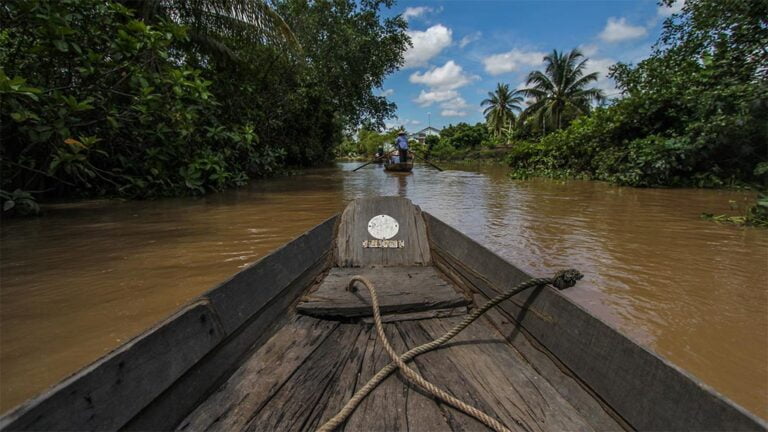
The Mekong River is one of the mightiest rivers in Asia. It is the world’s 12th longest river and it crosses through 6 countries – China, Burma, Laos, Thailand, Cambodia, and Vietnam. With an incredibly diverse eco-system, the Mekong is the life-blood for many communities in these areas – providing not only food, but also a transport system and tourism interest.
The Mekong River in Cambodia
In Cambodia, the Mekong enters the country in the north east, at the border with Laos, in the province of Steung Treng. From there it flows south west through the provinces of Kratie, Kompong Cham, and Kandal, before meeting up with the Tonle Sap river in Phnom Penh. From here, the Mekong separates itself again and flows south to Vietnam – slightly to the east of the Tonle Bassac river – a distributory river of the merging of the Mekong and the Tonle Sap.
A unique river system
The Mekong contributes to Cambodia’s unique river system. In dry season, the Tonle Sap flows into the Mekong where the two rivers meet in Phnom Penh. In rainy season, when the Mekong’s waters are high, the volume of water pushes the flow from the Tonle Sap back up north, reversing the seasonal flow of the river and flooding the Tonle Sap lake and the surrounding plains. This reversal in flow of the Tonle Sap and the related flooding helps support Cambodia’s wildlife, rice farming, and even the stability of the Angkor Temple foundations.
Wildlife on the Mekong
The Mekong is really an eruption of wildlife. The area is said to be one of the richest areas of biodiversity in the world, second only to the Amazon basin. The WWF estimates that there are 20,000 plant species, 430 mammals, 1,200 birds and 800 reptiles and amphibians in the Greater Mekong Sub-region. National Geographic term it as the “world’s most productive river” due to its plethora of fish and its tendency to product array of “mega-fish” such as the giant catfish. Species under threat in the region include the Irrawaddy Dolphin, the Indochinese Tiger, and the Asian Elephant.
Tourism on the Mekong
Many people choose to explore this part of South East Asia through a cruise or boat journey down a section of the Mekong River. It’s a fantastic way to explore the stunning rural landscapes in the area, and serves as an alternative point of entry to the usual cities and temples. For those who struggle with their sea legs, the Mekong highlights in Cambodia are in Kratie, Kompong Cham and Phnom Penh. In Kratie, you can take a local boat out early in the morning to go dolphin-spotting (most visitors are successful at seeing some), and Kompong Cham provides waterfront with some enjoyable local day trips in the surrounding area. In Phnom Penh, take a sunset boat cruise for an hour along the Tonle Sap until it merges with the mighty Mekong and watch Phnom Penh settle into dusk as you glide along.
Trade on the Mekong
The Mekong River is notoriously difficult to navigate, due to the high number of waterfalls and rapids along its length. Despite this, a large amount of trade is conducted via the Mekong, on the stretches that are possible to navigate easily. Most waterborne trade in Cambodia is conducted with Vietnam and a new deep-water port that was opened in Vietnamese Cai Mep in 2009 has done much to increase traffic and opportunity in the region.
The future for the Mekong
As such an important water and food source, the Mekong has of course its fair share of controversy. There are many hydroelectric dams along the river, and more are being planned for the future. Over-fishing and wildlife poaching is also a problem, as is nearby deforestation and the increase in trade and industry. It is not well understood what the long-term effect of these issues are likely to have on the fragile ecosystems, and a range of environmental organizations are campaigning for more thorough impact evaluations.